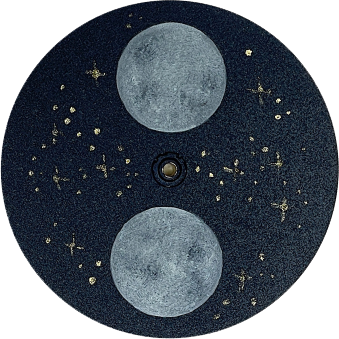Opus Perpetual
HIGHLIGHTS
- Perpetual calendar, metal bar (Aluminium), tubular gong
- Funnel-shaped starry sky with 10 diamonds, 6 jubilee jewels as indexes
- Limited to 60 pieces
THIS COMPLEX WORK OF ART FEATURES A PERPETUAL CALENDAR − FROM WHICH THE OPUS PERPETUAL TAKES ITS NAME
PERPETUAL CALENDAR
HOW DOES THE PERPETUAL CALENDAR IN THE CALIBRE 2051 WORK? In the calibre 2051 by the Erwin Sattler manufacture, the central hour wheel drives the calendar mechanism. This turns on its own axis once every 12 hours, making it necessary to halve the rotational speed just once every 24 hours in order to advance the indicators correctly. To account for the peculiarities of the Julian calendar, in which months have different lengths and there is a leap year after three normal years of 365 days, a component known as a month cam is required. Ridges and indentations signal how long the relevant month is to the main switching lever, which “feels” the edge of this specially shaped component. Since February has 28 days three times and then 29, a four-year wheel is needed too, which rotates 90 degrees a year in a cut-out on the month cam.

At the end of the month, the main switching lever works together with a toothed snail disc. In months that have 31 days, which are marked by ridges on the month cam, the pawl of the main switching lever moves completely normally over the tooth, advancing the date and month indicators by one position as it does so. If a month has less than 31 days, however, the rear end of the main switching lever moves deeper into the month cam accordingly. This makes it go back further, so the pawl moves over the aforementioned tooth after 30, 29 or 28 days instead, thereby advancing the calendar to the first day of the following month. The day and month displays remain unaffected by this. The calendar mechanism moves one position on every day.

| Case | - Metal bar (Aluminium) with olive root wood cassette, hand-polished - Metal bar (Aluminium) with carbon cassette, hand-polished Height: 150 cm, width: 40 cm, depth: 23 cm |
| Crystals | Mineral glass, anti-reflective |
| Power reserve | Sattler calibre 2051 |
| Power reserve | 30 days |
| Drive | Weight going train 6,800 g with pulley, weight strike train 6,800 g with pulley |
| Oscillator | Invar pendulum Ø 12 mm, temperature and air-pressure compensation with twin barometer |
| Ball bearings | 48 precision ball bearings |
| Jewel bearings | 4 in screwed-in chatons, 2 agate anchor pallets |
| Dial | Anodised, skeletonised, three-dimensional moon phase with 10 diamonds (0.10 ct), funnel-shaped starry sky, perpetual calendar, seconds dial, 6 jubilee jewels as indexes, jubilee button |
| Hands | Blue steel hands, hand domed |
| Strike train | Half-hour rack strike train with tubular gong, strike train silencer |
| Beat rate | 3.600/h |
| Weight | 72 kg |
| Limited and numbered to 60 pieces |
CALCULATION OF THE MOON PHASE DISPLAY
- January
- February
- March
- April
- May
- June
- July
- August
- September
- October
- November
- December
- 1
- 2
- 3
- 4
- 5
- 6
- 7
- 8
- 9
- 10
- 11
- 12
- 13
- 14
- 15
- 16
- 17
- 18
- 19
- 20
- 21
- 22
- 23
- 24
- 25
- 26
- 27
- 28
- 29
- 30
- 31
- 2017
- 2018
- 2019
- 2020
- 2021
- 2022
- 2023
- 2024


25. Jan
24. Feb
25. Mar
24. April
23. May
22. June
21. July
19. Aug
18. Sept
17. Oct
15. Nov
15. Dec
Opus Perpetual
AN ABSOLUTE MASTERPIECE OF CRAFTSMANSHIP. THIS COMPLEX WORK OF ART FEATURES A PERPETUAL CALENDAR − FROM WHICH THE OPUS PERPETUAL TAKES ITS NAME
The advancement of the Opus Perpetual’s eponymous calendar, which is made up of 130 components, is truly a masterstroke of engineering. For energy reasons, advancement takes several hours for other movements, with the hands moving from one position to the next very slowly. This is not the case with the sensational precision pendulum clock from Erwin Sattler, however, thanks to its special design. Its movement features a melodious strike train too, which announces the full and half hours with sound. A separate weight even guarantees propulsion over 30 days. Its mass generates enough force to advance the calendar mechanism to the next day in just 12 seconds − i. e. during the 12 strikes at midnight − and also to the next month. The precision of the movement therefore remains completely unaffected.
The strike train in the Opus Perpetual offers yet another special feature. In contrast to simple designs that have a countwheel, the elaborate rack and snail mechanism guarantees that the clock will strike the correct hour even if the hands are moved forwards or backwards without waiting for the sequence of chimes to finish. A tubular gong provides pleasant sound quality. Should the clock’s owner only wish to enjoy its soft ticking, however, the strike train can be suppressed with a simple hand movement.
The beating heart of the precision pendulum clock is the calibre 2051, which is made in-house. Comprising 601 components in total, it is one of the most complex movements that clock manufacturer Erwin Sattler has ever produced. It goes without saying all parts are made of the very finest materials available, finished with care and lovingly put together. The wheels rotate between solid brass plates that are 4 mm thick. An electroplated nickel coating provides protection against oxidation. To reduce the masses in motion, the 24 gold-plated gear wheels are spoked as much as is technically feasible and sit upon solid, fully hardened steel arbors with precisely milled pinions. 48 stainless steel precision ball bearings and four chatoned jewel bearings ensure almost frictionless rotation. These elaborate measures serve to achieve functional perfection, reducing energy loss to an absolute minimum. The George Graham lever escapement has two agate pallets. A seconds pendulum with a 12 mm-thick invar rod, a steel-nickel alloy with minimal thermal expansion coefficients and a steel element to compensate for unavoidable fluctuations in temperature act as an oscillator.
The accuracy of the pendulum clock can be affected by changes in the air pressure too, which is why the Opus Perpetual has a bilateral barometric compensator on the pendulum rod: When the air pressure rises, the aneroid capsules are pushed together. This causes the weights on the capsules to move downwards, shifting the entire pendulum’s centre of gravity accordingly. Similarly, the two weights are raised when the air pressure falls. The two tungsten weights (weighing 6,800 g each) for the gravity drive are attached to ball-bearing rope pulleys. These sophisticated structures have a positive effect on accuracy, and providing the Opus Perpetual is regulated carefully, its monthly drift is as low as one or two seconds.
The Opus Perpetual also takes its exceptional aesthetics from its attractive case, which protects and houses the technologically impressive movement. Made from massive aluminium, the 152 cm-high, 39 cm-wide, 22 cm-deep case will draw the eye to any wall it is placed against. The look is completed by a lively olive root wood cassette, while the pane of antireflective mineral glass provides a tantalising glimpse inside. On request, the cassette can also be made in a different wood or in carbon. To celebrate its anniversary fittingly, the Erwin Sattler manufacture is making only 60 Opus Perpetual timepieces. The number of each piece is indicated by a plaque at the “6” on the skeletonised dial.
The duration of the OPUS PERPETUAL is 30 days.
The OPUS PERPETUAL has the following dimensions: height: 150 cm, width: 40 cm, depth: 23 cm.
